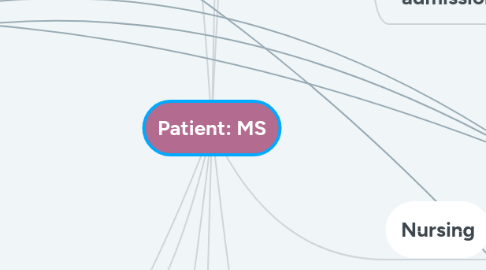
1. Admitting diagnosis: Bronchopneumonia
1.1. On Exam:
1.1.1. Productive Cough
1.1.1.1. Chest pain
1.1.1.1.1. Acetaminophen
1.1.2. Increased WOB
1.1.3. Bilateral lower lung lobe wheeze
1.1.4. SOBOE
1.1.4.1. Salbutamol
1.1.4.1.1. Bronchodilator: Selective beta 2-adrenergic receptor agonist₁₅
1.1.4.1.2. Relaxes airway smooth muscle, increasing airflow₁₅
1.1.5. Fatigue
1.1.5.1. Deconditioning
1.1.5.1.1. Decreased mobility
1.2. 2L o2 required to keep sats above 90%
1.2.1. Activity intolerance related to impaired respiratory function₇
1.2.2. Barrier to discharge: o2 requirements
1.2.2.1. Pt upset about needing o2
1.2.2.1.1. Spoke with patient about current coping methods, and recommended alternate ones
1.2.3. Priority to address: physiological need₄
1.3. Working daily with respiratory therapy
1.3.1. Extremely fatigued after sessions
1.4. Most common distribution of pulmonary infection, inflammation spreading from terminal bronchioles to their related alveoli. ₅
2. Lab Values
2.1. WBC:15.9
2.2. Neutrophil:13.1
2.3. K+: 3.4
3. Gastrointestinal System
3.1. Diarrhea
3.1.1. Encouraged increased oral fluid intake
3.1.2. Assisted to washroom regularly to prevent falls or incontinence
3.2. Decreased appetite
3.2.1. Awaiting consult with dietician
3.2.1.1. Family expresses interest in learning about dietician recommendations
3.2.2. Eating less than 50% of meals
3.2.2.1. States she is not hungry
3.2.2.2. States she misses food from home
3.2.2.2.1. Pt believes she will eat better in a home environment
3.2.2.2.2. Pts family brought in food from home for patient to eat
3.2.2.3. Nutrition, Imbalanced: Less than body requirements₇
3.2.2.3.1. Provided patient and daughter teaching on importance of nutrition in healing₃
3.2.2.4. Priority to address: food is physiological need₄
4. Orientation
4.1. Typically alert and oriented
4.2. Brief periods of the day where pt is not oriented to time, and confused about family members
4.2.1. Patient easily reoriented when this occurs
5. Legend
5.1. Family and/or Enviroment Involvement
5.2. Medication
5.3. Social Determinant of Health
5.4. NANDA Diagnosis
5.5. Barriers to discharge
5.6. Intervention
5.7. Abnormal assessment finding
5.8. Response
5.9. Pathophysiology
6. Patient Information
6.1. Female
6.2. 85Y
6.3. R1
7. Mobility
7.1. 1PA
7.1.1. Use of walker for ambulating
7.1.1.1. Working with PT and OT
7.1.1.1.1. Regaining independence in ADLs
7.1.1.1.2. Gaining strength to return to independent lifestyle
7.1.2. Barrier to discharge: Decreased mobility and inability to perform ADLS
7.1.2.1. Worked with pt to perform ROM exercises
7.1.2.2. Ambulated with pt in hallway
7.1.2.3. Encouraged independence in ADLS
7.2. No mobility aids used at home prior to admission
7.2.1. Family concerns of going home with limited mobility
7.2.1.1. Lives at home in multilevel house with granddaughter outside Edmonton
7.2.1.1.1. SDOH: Physical enviroment
7.2.1.1.2. Fall risk with multiple levels of stairs
7.2.1.1.3. Strong family supports
7.2.2. Often went for walks in neighbourhood before admission
7.2.2.1. SDOH: Healthy Behaviours
7.2.2.1.1. Pt expressed distress that she may not be able to continue with her walks upon discharge due to mobility changes
8. Medical History and Meds
8.1. Hypothyroidism
8.1.1. Deficient production of TH by the thyroid gland₁₇
8.1.1.1. Levothyroxine
8.1.1.1.1. Hormone₉
8.1.1.1.2. Replacement or supplementation of endogenous thyroid hormone, increased metabolic rate of body tissues₉
8.2. Hypertension
8.2.1. Consistent elevation of systemic arterial blood pressure₁₆
8.2.1.1. Became poorly controlled over previous months
8.2.1.1.1. Amlodipine
8.2.1.2. Ramipril
8.2.1.2.1. ACE inhibitor₁₀
8.2.1.2.2. Prevents conversion of angiotensin I to angiotensin II, which reduces sodium and water retention and lowers BP₁₀
8.3. Hypercholesterolemia
8.3.1. Excess of cholesterol in the bloodstream₁₈
8.3.1.1. Atorvastatin
8.3.1.1.1. Lipid lowering agent₁₂
8.3.1.1.2. Inhibits HMG-CoA reductase - enzyme responsible for catalyzing an early step in the synthesis of cholesterol₁₂
8.4. Osteoarthritis
8.4.1. Most common age-related disorder of synovial joints₁₉
8.5. GERD
8.5.1. Back flow of gastric or duodenal contents or both into the esophagus and past the lower esophageal sphincter without associated belching or vomiting₂₀
8.5.1.1. Pantaprazole
8.5.1.1.1. Proton pump inhibitor₁₃
8.5.1.1.2. Binds to an enzyme in the presence of acidic gastric pH, preventing the final transport of hydrogen ions into the gastric lumen₁₃
9. Dermatitis to Upper Back
9.1. Chronic skin disorder characterized by superficial skin inflammation and intense itching ₆
9.1.1. On Exam:
9.1.1.1. Red, raised rash
9.1.1.2. States itchy and uncomfortable
9.1.1.2.1. Washed skin with cool water
9.1.1.2.2. Encouraged pt not to itch with nails
9.1.1.3. Has had rash in same location previously
9.1.1.4. Noticed about two weeks ago
